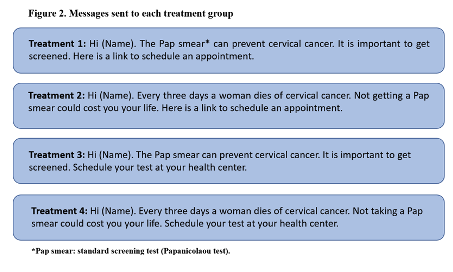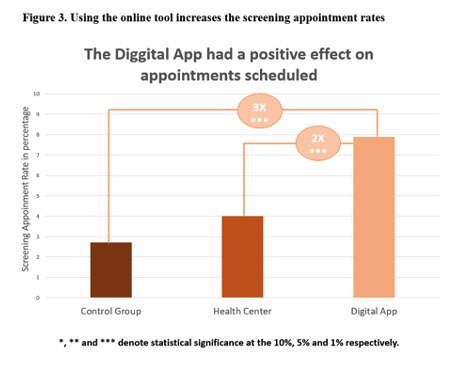Increasing cervical cancer screening with a digital tool and reminders

Context
A critical issue in public policy and development economics is how to increase the take-up of public services. In some countries these services notably include cervical cancer screening, an important part of preventive health programs, where low take-up rates represent a major concern because of their potential impacts on early detection rates and mortality rates. Cervical cancer is one of most common causes of female mortality worldwide and one of the most treatable forms of cancer given early detection and management. Nevertheless, many women do not undergo standard screening tests, even when they are offered free of cost by a health provider. While low take-up of public benefits represents a significant obstacle to the provision of health services, it also provides an opportunity to test the effectiveness of digital and behavioral science tools to improve public services provision.
The project
To increase the take-up of cervical cancer screening, the IDB partnered with the Uruguayan Ministry of Health and Digital Government and Information and Knowledge Society Agency to design and implement an online appointment system. Within the implementation of the online appointment system, a field experiment was conducted encouraging women via text messages to make medical appointments using the digital application or reminding them to make appointments as usual at their local clinic. The intervention took place between November 2019 and February 2020.
Behavioral Analysis
Behavioral Barriers
Hassle factors: Women in this context, while having the intention to undergo their regular cancer screening, might fail to follow through because of delays in waiting rooms and transaction costs related to appointment scheduling.
Lack of information: People may lack relevant information because, for instance, information is difficult to obtain, scarce, or hard to understand. Women might not be fully informed about the importance of getting screened and the severity of the illness.
Behavioral Tools
Simplification: Reducing the effort required to perform an action by making the message clearer, cutting the number of steps involved or breaking down into simple, easier steps a complex goal. We designed and implemented an intervention using a digital application that simplifies the process of scheduling cervical screening appointments.
Framing: Given the tendency to draw different conclusions depending on how information is presented, the desired options can be presented to emphasize the relevant part of the information, as well as to highlight the positive or negative aspects of a decision, leading an option to be perceived as more or less attractive. In this case, we sent messages with benefit-framed or risk-framed information on cervical screening. The benefit-framed information highlighted that cervical screening could prevent cervical cancer, and the risk-framed information highlighted that not getting a cervical screening can prove fatal.
Reminders: These may consist of an email, text messages, a letter, or a personal visit to remind the person making the decision about some aspect of their decision-action. Reminders are aimed at mitigating procrastination, forgetfulness, and cognitive overload for those who must make the decisions. In this case, women who booked their appointment through the digital application received a reminder via text message 48 hours prior to their appointment.
Intervention Design
Aiming to ease the barriers of transaction cost in appointment scheduling, we partnered with the Government of Uruguay to design and implement an online tool to schedule cervical screening appointments with healthcare providers. Users can make their own appointments by simply using their national identification number and selecting their preferred health center and screening date.

The intervention consisted of text messages reminding women to schedule a cervical screening appointment either using the online tool or by contacting their local clinic. Our intervention consisted of four treatments and one control group. Treatments 1 and 2 were informational text messages sent with a link to use the online scheduling tool. Treatments 3 and 4 were informational text messages sent with a recommendation to schedule appointments at the health center as usual. We also provided benefit or risk information in the text messages. Messages in Treatments 1 and 3 emphasized the benefits and importance of undergoing cervical screening. Messages in Treatments 2 and 4 highlighted the importance of the cervical screening considering the risks associated with cervical cancer. Women in the control group continued with the health center’s standard procedures regarding appointment scheduling and did not receive any communications or additional information. Women who made appointments through the online channel were also sent one reminder message 48 hours prior to their appointment.
Messages were sent on a rolling basis each Tuesday afternoon starting on November 18, 2019, until February 11, 2020. Each woman could receive at most four messages over four weeks. If during that period the recipient scheduled an appointment, she stopped receiving messages. In total, 47,600 women participated in this project: ,5700 in each treatment and 24,800 in the control group. The intervention ended before the COVID-19 emergency started in the country, and the provision of public health services was not interrupted by the pandemic.

To identify the potential mechanisms driving our main results, we surveyed a subgroup of participants on their knowledge about the cervical screening test, their beliefs about the importance of testing, and costs and obstacles they face when making and attending medical appointments.
Challenges
The main challenge with online tools, especially messaging systems, is that even if messages are successfully delivered, delivery does not guarantee that messages are opened and read by recipients.
Results
- Providing an online tool to book appointments increases the rate of appointments scheduled for cervical screening. Figure 3 shows that the screening appointment scheduling rate of women using the online tool was twice that of women who received reminders to schedule in their Health Centers, and three times the scheduling rate of the control group.
- Providing an online tool to book appointments also increases the attendance rate at cervical screening appointments. Figure 4 shows that women using the online tool were 1.5 times more likely to attend an appointment they scheduled than women who received reminders to schedule it at their Health Centers, and 2.6 times more likely to attend the appointment than women in the control group.
- There is no difference between benefit-frame and risk-frame messages.
- From the surveyed subgroup, the researchers learned that women were well informed about cervical screening and its importance. Thus, it appears that the information they received about cervical screening through the text messages was more a reminder of cervical screening than new information.
- Providing an online tool diminishes the transaction cost of scheduling an appointment.


Policy Implications
- The project shows that an online tool for scheduling appointments can be a valuable instrument for governments to increase the take-up of public services.
- Given widespread internet access and use of mobile phones, implementing the use of online represents an important opportunity to reduce transaction costs for accessing public services, as well as reduce bureaucracy and waiting times.
- Tools like this can be developed for and with governments in Latin America and the Caribbean by the IDB.
